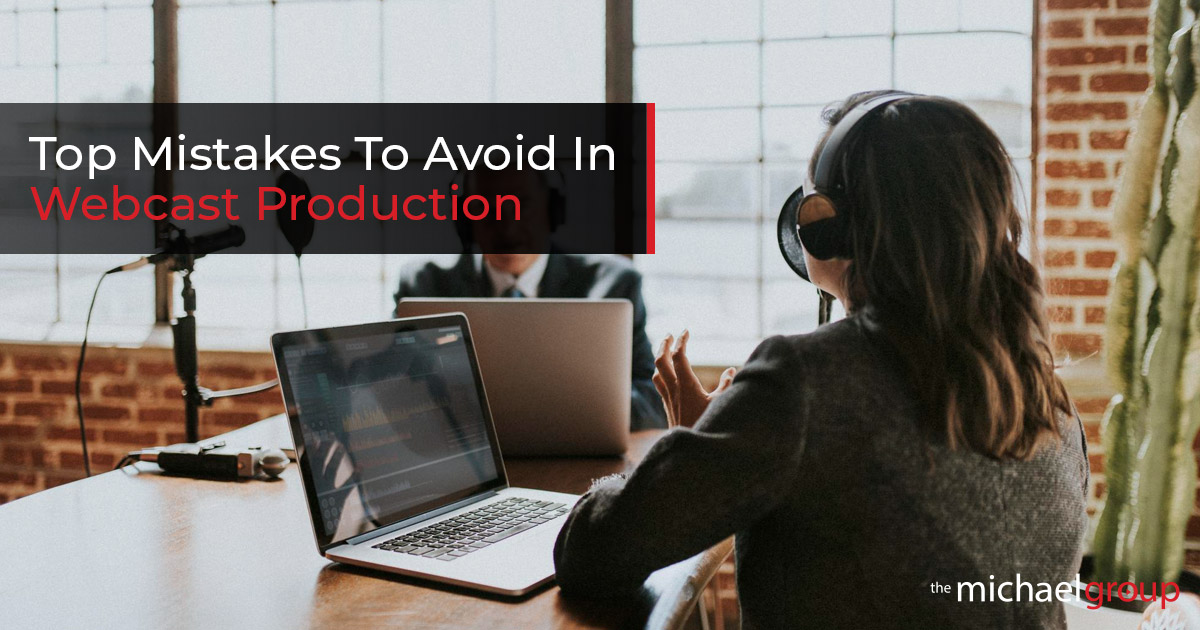
Can you imagine a world without the internet? As a society, we’ve moved far beyond using it just for directions or recommendations. We now rely on the internet for entertainment, news, and meaningful connections. That’s where webcast productions shine, serving as powerful tools for corporate communication, training, marketing, and even entertainment. But here’s the catch: a poorly produced webcast can harm your brand just as much as a great one can boost it.
To get the most from your webcast, work with a professional webcasting team and steer clear of common pitfalls. Wondering what those mistakes are? Let’s dive in!

Webcasting is the live streaming of video and audio over the internet, and while it happens in real time, preparation makes all the difference.
Take a moment to consider that the live streaming market is projected to grow by USD 20.64 billion between 2024 and 2029. This growth highlights the rising popularity of webcast production, with audiences consuming online content worldwide. Increasingly, businesses and content creators are recognizing its potential as a medium that can reach and engage audiences anywhere, anytime.
With strategic planning, webcasts can deliver many benefits, including:
While webcast production can offer these benefits, they’re not guaranteed. Poor planning and execution can result in an amateur production that misses the mark.
Identifying these mistakes and taking steps to prevent them ensures that your webcast production goes off without a hitch. Here are a few common mistakes to consider during planning.
Without the benefit of advanced cinematic effects or extensive post-production, webcasts rely heavily on smooth audio and visual quality. Crackling, muffled, or inconsistent sound quickly loses audience attention, while background noise, echo, and uneven volume make content hard to follow and reflect poorly on your brand.
With a professional team, you can ensure your webcast is recorded using high-quality microphones, proper sound checks are conducted, and acoustic measures are in place for clear audio.
Viewers don’t expect professional color grading in webcasts, but they do expect bright, evenly lit sets that are easy to watch without straining. Neglecting professional lighting can result in overly harsh, dim, or uneven light that makes presenters look tired or unprofessional, reducing audience engagement and the overall impact of the production.
With a professional team, you can use a three-point lighting setup and adjust the set lighting to ensure presenters look natural and approachable. Our experienced team provides the necessary filming equipment and checks camera exposure in advance, ensuring your production is presented—literally—in the best light.
One of the best benefits of webcast production is meeting your audience where they are. However, a common mistake is overlooking their accessibility needs by choosing the wrong platform or failing to prepare for technical glitches. Lag, screen-sharing delays, or compatibility issues can disrupt the experience and leave a negative impression.
Professionals know how to choose platforms that suit the audience size, region, and likely devices. With our team, you can run rehearsals, test bandwidth, and have a reliable backup plan (such as a secondary platform or recording) in case of technical difficulties.
It’s a good idea to include some visuals that boost audience engagement. However, some webcast efforts incorporate too much text or busy graphics that overwhelm the viewers and distract from the presenter. Keep in mind that a webcast production is not a PDF presentation but a live visual experience, and these graphics should be used strategically and kept to a minimum.
If your production would benefit from visual assets, our team can create clean, minimal graphics that emphasize key points and reinforce your message without causing distractions.
Much of a webcast’s success depends on the presenter. A well-prepared presenter can overcome technical issues, handle conversational hiccups, and keep the audience engaged. However, even strong speakers may appear nervous or disorganized without preparation. A common mistake is having a presenter who rambles in a monotone or lacks pacing, causing the audience to lose interest.
In this case, preparation is key. With the right support, presenters can be ready through briefings, rehearsals, and well-prepared talking points. Training on pacing, camera contact, and engagement strategies also helps, and a webcast production team can provide valuable guidance in all these areas.
One of the great advantages of webcast production is the opportunity for live engagement. Few platforms offer such direct access to the audience. However, many brands still treat webcasts like a one-way lecture, neglecting interaction and quickly losing viewer interest.
An experienced webcast production team will know when and how to integrate Q&A sessions, live polls, or breakout discussions, and can prepare the presenter to moderate effectively. They can identify key moments where addressing audience input adds real value.
Even a well-prepared webcast can fall flat if no one attends, and its impact can fade quickly without post-event follow-up. A common mistake is treating the webcast as a standalone event that will succeed on its own. In reality, it needs strong pre-event marketing and post-event engagement to maximize results.
It’s necessary to build a promotion strategy with email campaigns, social media teasers, and calendar invites. A webcast production team can also assist in sharing the recording afterward, along with thank-you notes, and providing additional resources to keep the conversation going. These small efforts can make a big difference in the success of your webcast.

One of the most effective ways to counter potential pitfalls is to have an experienced webcast production team on your side, guiding you through each step and assisting with any issues that arise. However, it’s important to choose a team that aligns with your values and goals so you can work together as a cohesive unit.
If you’re new to webcasting, choosing a partner can feel daunting. Here are a few tips to help you find the right team:
At The Michael Group, we’re proud to offer our experienced webcast production team to businesses in Chicago, Los Angeles, and New York. We bring expert guidance and technical know-how to your next webcasting project. Ready to learn more? Call us at (312) 498-440 or contact us online.